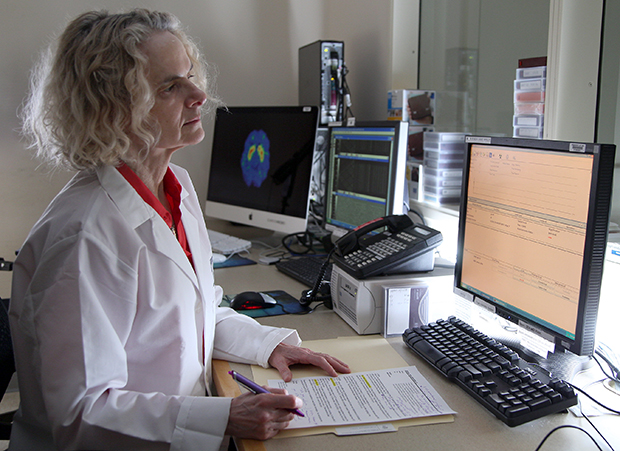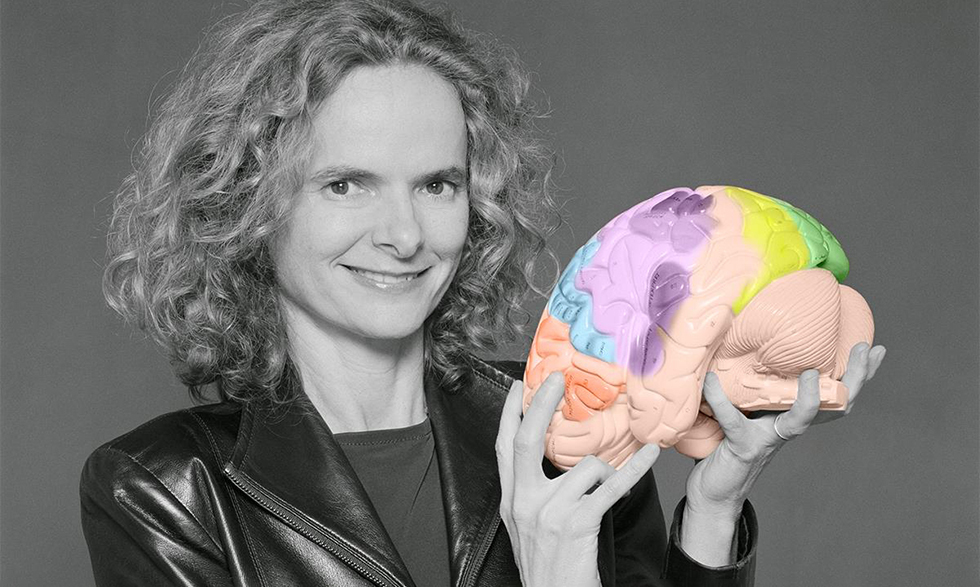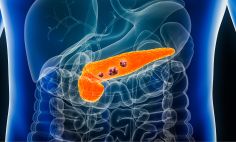Nora Volkow, M.D., has been the director of the National Institute on Drug Abuse (NIDA) since May 2003. NIDA supports research on the health aspects of drug use and addiction. As a research psychiatrist, Dr. Volkow uses brain imaging to study how substance use affects the brain. Her work has helped show how addiction is a chronic disease best addressed with prevention and treatment rather than judgment and punishment.
What made you want to study addiction and substance use disorders?
I was born in Mexico. My father is a chemist, and I always liked medicine and science―I was particularly fascinated by the brain. My family had a tragic history related to discrimination and shame around alcoholism. My favorite uncle had a problem with alcoholism, but this was a secret in the family that nobody spoke about. That silence was hard for me to understand. I didn’t know until later, but my mother’s father was also an alcoholic who had tried to stop drinking and ended up killing himself.
When I was in medical school, I was frustrated to see substance use issues ignored. The curriculum addressed the physical impacts of alcoholism but not the causes of addiction. Individuals with both mental illness and addiction have worse outcomes than those with one or the other, but resources to take care of people struggling with both of these issues were not prioritized.
I went into psychiatry because I was fascinated by the brain. If someone has a neurological problem like Alzheimer’s disease, you can see the disease in the brain. But that’s not true for mental health issues, and I wanted to understand that.
During addiction, there’s a disconnect between what you want to do and what you’re able to do. The need for the drug becomes as strong as the need for food or oxygen, and you can’t stop taking the substance even though consciously, you may not want it. I wanted to understand how something this powerful gets imprinted in the brain and what’s happening in the brain when someone loses control over their behavior, even if their brain looks normal on a scan.
I saw how addiction affected my family and the vulnerabilities we all had because of it. I wanted to understand how genetic vulnerabilities affect the brain and what factors drive behavior in addiction―scientifically, but also personally.
What brought you to NIDA?
When NIH asked me to apply for the [NIDA director] position, they said I would have the opportunity to develop impactful policies. This was appealing because I wanted to address the ways that our society and health care systems neglect addiction and to work to change the criminalization of people who take drugs. Research shows that when people end up in jail or prison, they have a much higher chance of overdosing, dying, or relapsing. Criminalizing people who use drugs has created a structurally racist system that allows us to treat certain people, particularly Black Americans, worse than others.
Could you describe some of NIDA’s primary research initiatives and studies?
We are conducting two large longitudinal studies that use neuroimaging [scans of the brain] to learn about child brain development, behavior, and health. The HEALthy Brain and Child Development Study (HBCD) follows a large group of pregnant women and their children across the country, from pregnancy through early childhood, and the Adolescent Brain Cognitive Development Study (ABCD) follows more than 11,000 children from different racial and ethnic backgrounds across the United States, from ages 9 to 10 through early adulthood. Both studies are looking at what factors in a child’s environment, genes, biology, and social relationships―including exposure to harmful substances and stressors―affect brain development and behavior. This will give us a better understanding of the things that make it more likely―or less likely―for someone to develop a substance use disorder so we can intervene early on and prevent and treat harmful outcomes like addiction later in life.
We support research to identify and develop new treatments, including research on the pharmacological effects of different drugs―what they do in the brain, in the cells, to the genes―to find ways to tailor personalized therapies. We’re also studying ways to implement effective treatments and get them covered by insurance.
And we’re very involved in policy and translational research so we can bring interventions into different communities. How do we learn from what other diverse groups are doing to address this crisis in their communities? What works well? What doesn’t?

Dr. Nora Volkow, a pioneer in addiction science, uses brain imaging to study how substance use affects the brain.
How do health disparities play into substance use and addiction, and how is NIDA addressing the needs of people affected by these issues in underserved communities?
There are health disparities in all areas of health, especially around substance use. What’s unique to addiction is how it relates to criminalization. Being in jail or prison interferes with physical and emotional health, makes it hard to get a job, disrupts families, and destroys self-confidence. We’re trying to tackle these issues at NIDA.
For one, we have the Justice Community Opioid Innovation Network (JCOIN), which is part of NIH’s broader Helping to End Addiction Long-term (HEAL) Initiative. JCOIN tests strategies for improving access to high-quality treatment and care for people with opioid use disorder in justice settings.
Another of our research priorities to help address health disparities is to conduct large-scale studies like ABCD that allow us to look at brain development and health outcomes over time in children who come from disadvantaged backgrounds. We know that income is a key factor, and on average, people of color have lower incomes than White Americans. These families are less likely to have access to good health care and nutritious foods, and the parents often work extra shifts, which can affect sleep quality.
Understanding how stressful environments and experiences like discrimination in school or unsteady home lives impact differences in children’s brains and health will allow us to develop more effective interventions for preventing and treating substance use and addiction. We want to push the envelope in our research, but we also want to promote treatments that are sustainable and accessible for the people who need them.
How does stigma affect the health, treatment, and well-being of people with substance use disorders? How does it affect their networks and communities?
Stigma seeps in at every level, affecting individual and community suffering, the health care system, and health insurance coverage.
Individuals, families, and communities internalize stigma around substance use. It is something that everyone is ashamed to talk about, and that gets in the way of people getting the help they need. This has created a health care system that doesn’t provide the resources to treat addiction and insurance companies that won’t pay for effective treatments.
Why are you trying to change the institute’s name to the National Institute on Drugs and Addiction?
Language is the most unique advantage humans have over animals because it allows us to build. We use language to build shared realities and to build identities. It’s how we communicate with each other, and the words themselves are powerful. You respond emotionally to a word based on your association with it, and you can actually see this in the brain, where certain words activate the amygdala [the part of the brain that prepares us to respond to threats].
We call people who use drugs “abusers,” but the word “abuse” has very negative associations. So our brains connect that term with other terms like “sexual abuse” and “physical abuse,” which creates a negative opinion of that person.
We will still be NIDA, but it’s important to change the “A” to “addiction” instead of “abuse.”
How has the COVID-19 pandemic contributed to increased substance use, overdoses, and deaths, and what other factors are at play?
The pandemic has caused enormous stress and uncertainty for people―people have lost homes, jobs, and loved ones, and this stress contributed to increased drug use. It also stressed the health care system. Community services, emergency departments, and methadone treatment programs became overwhelmed or were shut down, which made it harder for people to get services and treatment.
On top of this, synthetic opioids like fentanyl became far more widely available. Fentanyl is 50 times more potent than heroin and can be fatal even at low doses. Originally, it was used to contaminate heroin, but now it is showing up in drugs like cocaine, methamphetamines, and illegal counterfeit prescription pills, which puts more people at risk of overdosing from it.
So as people are using more drugs, the drugs themselves are much stronger and more dangerous than in the past.
What are the most important next steps to address the overdose crisis?
This crisis is not going to go away by itself. It requires a multipronged, tailored approach to interventions that’s targeted at different stages.
First, we need to educate the public about fentanyl. This includes tailored education that’s factual and relevant to specific communities.
We also need to provide treatments and interventions that protect people from overdoses. This includes prioritizing behavioral health and training clinicians to screen for substance use.
Finally, we need to make overdose reversal medication available for any individual who uses drugs. Naloxone is a safe medication that can save lives, and it should be widely available, including in schools.
What are the most important things that you think people need to know about substance use and addiction that they may not already know?
Substance use disorders are both a chronic brain disease and a social problem. Societal factors [things like access to food and transportation, housing security, education, violence, and social support] have the power to create conditions that make people vulnerable to substance use and addiction, and they also have the power to facilitate recovery. But this doesn’t erase the fact that addiction is a chronic disease of the brain.
Addiction is treatable, but we need to treat it as a chronic condition. It causes long-term changes to the brain that are compounded by changes in behavior. These changes don’t reverse when you stop taking drugs. The longer someone is in treatment, the less likely they are to relapse; eventually, most people will achieve remission [when you are no longer dependent on the substance].
The people who are the most vulnerable can be those who are socially deprived, and it’s narrow-minded to believe that people take drugs because they choose to. For example, you see people experiencing homelessness with high rates of smoking and alcohol use and with high overdose rates. These individuals don’t have anything else, and many of them take drugs as a way to escape, to feel better, because they have no other options. And many are struggling with other mental illnesses. Instead of stigmatizing people by saying that this behavior is a choice, we need to ask what we can do to provide alternative behaviors, resources, and support so that everyone has actual choices.
What do you like to do when you’re not working?
I love to explore the world. I love to run and hike. And I love to read. Books let you get into someone else’s brain and explore the uniqueness that’s there.







